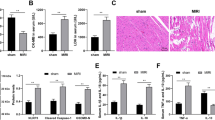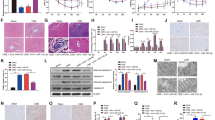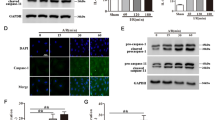Abstract
This study investigated how miR-136-5p partially affected cardiomyocyte pyroptosis in rats with coronary microembolization (CME). The cardiac function and structure of rats with CME were evaluated using echocardiography, hematoxylin and eosin staining, Masson staining, and troponin I level. Pyroptosis was induced by lipopolysaccharide (LPS) in isolated rat cardiomyocytes and evaluated by the expression of caspase-1, NOD-like receptor family pyrin domain-containing 3, interleukin-1β, and gasdermin D–N. After cell transfection, the expression of Ataxin-1 like (ATXN1L), pyrin domain-containing 1 (PYDC1), and pyroptosis-related proteins was assessed. Dual-luciferase reporter and immunoprecipitation assays were used to verify the relationships among miR-136-5p, ATXN1L, and capicua (CIC). MiR-136-5p was under-expressed, whereas ATXN1L was overexpressed in rats with CME and in LPS-treated primary cardiomyocytes. MiR-136-5p targeted ATXN1L, and ATXN1L bound to CIC to suppress PYDC1 expression. MiR-136-5p overexpression suppressed pyroptosis by inhibiting the binding of ATXN1L with CIC and promoting PYDC1 expression, which was reversed by simultaneous elevation of ATXN1L. In conclusion, miR-136-5p suppressed pyroptosis by upregulating PYDC1 via ATXN1L/CIC axis, thereby attenuating cardiac damage caused by CME.








Similar content being viewed by others
Data availability
The datasets used or analyzed during the current study are available from the corresponding author on reasonable request.
References
Gac P, Poreba M, Pawlas K et al (2017) Influence of environmental tobacco smoke on morphology and functions of cardiovascular system assessed using diagnostic imaging. Inhal Toxicol 29:518–529
Pettersen TR, Fridlund B, Bendz B et al (2018) Challenges adhering to a medication regimen following first-time percutaneous coronary intervention: a patient perspective. Int J Nurs Stud 88:16–24
Kretzschmar D, Jung C, Otto S et al (2012) Detection of coronary microembolization by Doppler ultrasound in patients with stable angina pectoris during percutaneous coronary interventions under an adjunctive antithrombotic therapy with abciximab: design and rationale of the High Intensity Transient Signals ReoPro (HITS-RP) study. Cardiovasc Ultrasound 10:21
Wang J, Chen H, Zhou Y et al (2016) Atorvastatin inhibits myocardial apoptosis in a swine model of coronary microembolization by regulating PTEN/PI3K/Akt signaling pathway. Cell Physiol Biochem 38:207–219
Emini Veseli B, Perrotta P, De Meyer GRA et al (2017) Animal models of atherosclerosis. Eur J Pharmacol 816:3–13
An TH, He QW, Xia YP et al (2017) MiR-181b antagonizes atherosclerotic plaque vulnerability through modulating macrophage polarization by directly targeting Notch1. Mol Neurobiol 54:6329–6341
Heusch G, Skyschally A, Kleinbongard P (2018) Coronary microembolization and microvascular dysfunction. Int J Cardiol 258:17–23
Skyschally A, Walter B, Heusch G (2013) Coronary microembolization during early reperfusion: infarct extension, but protection by ischaemic postconditioning. Eur Heart J 34:3314–3321
Song Y, Yang L, Guo R et al (2019) Long noncoding RNA MALAT1 promotes high glucose-induced human endothelial cells pyroptosis by affecting NLRP3 expression through competitively binding miR-22. Biochem Biophys Res Commun 509:359–366
Olivier E, Dutot M, Regazzetti A et al (2017) 25-Hydroxycholesterol induces both P2 × 7-dependent pyroptosis and caspase-dependent apoptosis in human skin model: new insights into degenerative pathways. Chem Phys Lipids 207:171–178
Mao Q, Liang XL, Zhang CL et al (2019) LncRNA KLF3-AS1 in human mesenchymal stem cell-derived exosomes ameliorates pyroptosis of cardiomyocytes and myocardial infarction through miR-138-5p/Sirt1 axis. Stem Cell Res Ther 10:393
Rauf A, Shah M, Yellon DM et al (2019) Role of Caspase 1 in ischemia/reperfusion injury of the myocardium. J Cardiovasc Pharmacol 74:194–200
Paraskevopoulou MD, Hatzigeorgiou AG (2016) Analyzing miRNA-LncRNA interactions. Methods Mol Biol 1402:271–286
Witwer KW, Halushka MK (2016) Toward the promise of microRNAs—enhancing reproducibility and rigor in microRNA research. RNA Biol 13:1103–1116
Lee S, Choi E, Cha MJ et al (2015) Looking for pyroptosis-modulating miRNAs as a therapeutic target for improving myocardium survival. Mediators Inflamm 2015:254871
Lin Y, Dan H, Lu J (2020) Overexpression of microRNA-136-3p alleviates myocardial injury in coronary artery disease via the Rho A/ROCK signaling pathway. Kidney Blood Press Res 45:477–496
Gao Z, Li Q, Zhang Y et al (2020) Ripasudil alleviated the inflammation of RPE cells by targeting the miR-136-5p/ROCK/NLRP3 pathway. BMC Ophthalmol 20:134
Rezkalla S, Kloner RA, Khatib G et al (1988) Effect of metoprolol in acute coxsackievirus B3 murine myocarditis. J Am Coll Cardiol 12:412–414
Wang H, Zhou X, Li H et al (2017) Transient receptor potential melastatin 2 negatively regulates LPS-ATP-induced caspase-1-dependent pyroptosis of bone marrow-derived macrophage by modulating ROS production. Biomed Res Int 2017:2975648
Yang D, He Y, Munoz-Planillo R et al (2015) Caspase-11 requires the pannexin-1 channel and the purinergic P2 × 7 pore to mediate pyroptosis and endotoxic shock. Immunity 43:923–932
Zhao LR, Xing RL, Wang PM et al (2018) NLRP1 and NLRP3 inflammasomes mediate LPS/ATPinduced pyroptosis in knee osteoarthritis. Mol Med Rep 17:5463–5469
Fernandes-Alnemri T, Wu J, Yu JW et al (2007) The pyroptosome: a supramolecular assembly of ASC dimers mediating inflammatory cell death via caspase-1 activation. Cell Death Differ 14:1590–1604
Mizutani A, Wang L, Rajan H et al (2005) Boat, an AXH domain protein, suppresses the cytotoxicity of mutant ataxin-1. EMBO J 24:3339–3351
Wong D, Lounsbury K, Lum A et al (2019) Transcriptomic analysis of CIC and ATXN1L reveal a functional relationship exploited by cancer. Oncogene 38:273–290
Srimathi T, Robbins SL, Dubas RL et al (2008) Mapping of POP1-binding site on pyrin domain of ASC. J Biol Chem 283:15390–15398
Bikou O, Tharakan S, Yamada KP et al (2019) A novel large animal model of thrombogenic coronary microembolization. Front Cardiovasc Med 6:157
Su Q, Li L, Zhao J et al (2017) Effects of trimetazidine on PDCD4/NF-kappaB/TNF-alpha pathway in coronary microembolization. Cell Physiol Biochem 42:753–760
Zhaolin Z, Guohua L, Shiyuan W et al (2019) Role of pyroptosis in cardiovascular disease. Cell Prolif 52:e12563
Jiang C, Jiang L, Li Q et al (2018) Acrolein induces NLRP3 inflammasome-mediated pyroptosis and suppresses migration via ROS-dependent autophagy in vascular endothelial cells. Toxicology 410:26–40
Fu Q, Wu J, Zhou XY et al (2019) NLRP3/caspase-1 pathway-induced pyroptosis mediated cognitive deficits in a mouse model of sepsis-associated encephalopathy. Inflammation 42:306–318
Guo M, An F, Yu H et al (2017) Comparative effects of schisandrin A, B, and C on Propionibacterium acnes-induced, NLRP3 inflammasome activation-mediated IL-1beta secretion and pyroptosis. Biomed Pharmacother 96:129–136
Tapia VS, Daniels MJD, Palazon-Riquelme P et al (2019) The three cytokines IL-1beta, IL-18, and IL-1alpha share related but distinct secretory routes. J Biol Chem 294:8325–8335
Shi J, Zhao Y, Wang K et al (2015) Cleavage of GSDMD by inflammatory caspases determines pyroptotic cell death. Nature 526:660–665
He WT, Wan H, Hu L et al (2015) Gasdermin D is an executor of pyroptosis and required for interleukin-1beta secretion. Cell Res 25:1285–1298
Zhou Y, Li T, Chen Z et al (2021) Overexpression of lncRNA TUG1 alleviates NLRP3 inflammasome-mediated cardiomyocyte pyroptosis through targeting the miR-186-5p/XIAP Axis in coronary microembolization-induced myocardial damage. Front Immunol 12:637598
Lei Q, Yi T, Chen C (2018) NF-kappaB-gasdermin D (GSDMD) axis couples oxidative stress and NACHT, LRR and PYD domains-containing protein 3 (NLRP3) inflammasome-mediated cardiomyocyte pyroptosis following myocardial infarction. Med Sci Monit 24:6044–6052
Qiu Z, He Y, Ming H et al (2019) Lipopolysaccharide (LPS) aggravates high glucose- and hypoxia/reoxygenation-induced injury through activating ROS-dependent NLRP3 inflammasome-mediated pyroptosis in H9C2 cardiomyocytes. J Diabetes Res 2019:8151836
Zhao AP, Dong YF, Liu W et al (2014) Nicorandil inhibits inflammasome activation and Toll-like receptor-4 signal transduction to protect against oxygen-glucose deprivation-induced inflammation in BV-2 cells. CNS Neurosci Ther 20:147–153
Su Q, Li L, Zhao J et al (2017) MiRNA expression profile of the myocardial tissue of pigs with coronary microembolization. Cell Physiol Biochem 43:1012–1024
Su Y, Zhu C, Wang B et al (2021) Circular RNA Foxo3 in cardiac ischemia-reperfusion injury in heart transplantation: a new regulator and target. Am J Transplant 21:2992–3004
Ghanbari M, Franco OH, de Looper HW et al (2015) Genetic variations in microRNA-binding sites affect microRNA-mediated regulation of several genes associated with cardio-metabolic phenotypes. Circ Cardiovasc Genet 8:473–486
Rip J, Nierman MC, Wareham NJ et al (2006) Serum lipoprotein lipase concentration and risk for future coronary artery disease: the EPIC-Norfolk prospective population study. Arterioscler Thromb Vasc Biol 26:637–642
Lee Y, Fryer JD, Kang H et al (2011) ATXN1 protein family and CIC regulate extracellular matrix remodeling and lung alveolarization. Dev Cell 21:746–757
Kim E, Lu HC, Zoghbi HY et al (2013) Structural basis of protein complex formation and reconfiguration by polyglutamine disease protein Ataxin-1 and Capicua. Genes Dev 27:590–595
Csont T, Murlasits Z, Menesi D et al (2015) Tissue-specific gene expression in rat hearts and aortas in a model of vascular nitrate tolerance. J Cardiovasc Pharmacol 65:485–493
Bunda S, Heir P, Metcalf J et al (2019) CIC protein instability contributes to tumorigenesis in glioblastoma. Nat Commun 10:661
Needham BL, Smith JA, Zhao W et al (2015) Life course socioeconomic status and DNA methylation in genes related to stress reactivity and inflammation: the multi-ethnic study of atherosclerosis. Epigenetics 10:958–969
Atluri VS, Pilakka-Kanthikeel S, Garcia G et al (2016) Effect of cocaine on HIV infection and inflammasome gene expression profile in HIV infected macrophages. Sci Rep 6:27864
Lachner J, Mlitz V, Tschachler E et al (2017) Epidermal cornification is preceded by the expression of a keratinocyte-specific set of pyroptosis-related genes. Sci Rep 7:17446
Funding
Thanks for the grants from the National Natural Science Foundation of China (Grant No. 81960079), the Natural Science Foundation of Guangxi Province (Grant No. 2020GXNSFDA238007; Grant No. 2020GXNSFFA297002), The Key Research and Development Program of Guangxi (Grant No. AB20159005), Guangxi BaGui Scholars Special Project and Guangxi Health Commission Key Laboratory of Disease Proteomics Research.
Author information
Authors and Affiliations
Contributions
CRP and XYL contributed equally to the manuscript, WRM and SQ had full access to all of the data in the study and takes responsibility for the integrity of the data, the accuracy of the data analysis, RYL and HSR wrote the manuscript draft. CRP, XYL and ZJ performed research. KBH and LQZ contributed substantially to the study design and the writing of the manuscript. YXH and DRX contributed to the manuscript preparation and statistical analysis. CRP and XYL revised the manuscript. All authors read and approved the final version of the manuscript.
Corresponding authors
Ethics declarations
Conflict of interest
The authors declare there is no conflict of interest regarding the publication of this paper.
Ethical approval
The experimental design complied with the implementation regulations for the management of medical experimental animals of the National Health and Planning Committee of China and the Guide for the Use and Management of Laboratory Animals of the National Institutes of Health. All study protocols were authorized by the ethics committee of Guilin Medical University.
Additional information
Publisher’s Note
Springer Nature remains neutral with regard to jurisdictional claims in published maps and institutional affiliations.
Supplementary Information
Below is the link to the electronic supplementary material.
10495_2022_1712_MOESM1_ESM.tif
Supplementary figure 1 Note: (A) Cardiomyocyte morphology; (B) Immunofluorescence analysis of cTnI expression in rat primary cardiomyocytes. Supplementary material 1 (TIF 11578 kb)
Rights and permissions
About this article
Cite this article
Cai, R., Xu, Y., Ren, Y. et al. MicroRNA-136-5p protects cardiomyocytes from coronary microembolization through the inhibition of pyroptosis. Apoptosis 27, 206–221 (2022). https://doi.org/10.1007/s10495-022-01712-5
Accepted:
Published:
Issue Date:
DOI: https://doi.org/10.1007/s10495-022-01712-5




